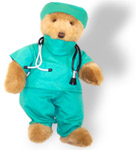As the calendar turned to a new year and we reached the 4 month mark, we were hopeful that our time in the hospital was about to come to an end.
As we've mentioned before, we never thought Nathan would be in the hospital this long. And it was taking it's toll on us both physically and emotionally. So we've decided to combine a couple of posts that we had originally decided to do separately and talk about how we stayed sane through it all.
Looking back now, there were 3 things that helped to keep us sane:
1) Before we had even spent a day in the hospital, we made the decision that we couldn't let "the situation" dominate our lives. As hard and as painful as it might be, we knew that we had to be the ones in charge of our lives. With so many unknowns and a lot of uncertainty, especially in the beginning, we knew we had to maintain a certain about of control and stability over whatever aspects of our lives that we could.
So we decided that we would come home every night so that we could be in our own home and comfortably sleep in our own bed. We decided that it was important to go to church with our own congregation instead of attending the services at the hospital. And I tried to work as much of a normal schedule as possible.
So even with so much out of our control, if we could stay in control of these little things, it would go a long way to making sure that everything didn't completely overwhelm us.
2) The second lifesaver on our list has to be the NICU Parent Hour. Every Wednesday at lunchtime, the Parent Coordinator and the NICU Social Workers would host a get-together for the NICU parents. We would have lunch, play games, have some type of informational training, and socialize with other parents.
Parent Hour was very, very therapeutic for us. First, it was nice to socialize with other parents who were going through similar experiences as yours. At the same time, though, and this may sound entirely weird to many of you, but it was very relieving to hear other parents describe why their babies were in the hospital and hear of their difficulties and think, "Oh, I'm glad that's not me."
Additionally, every few weeks, a group of three NICU graduate parents would come and share their lives with us. They would talk about what caused their children to need to be in the NICU, how long they had to stay, and life after the NICU. And their kids were now older (maybe 5 or 6 years old at the time), so they could talk about continued trials and things they had to deal with as their kids continued to grow up.
And, we became really, really good friends with the social workers. Shawnee, Shelley, and Annette were just amazing. While we were having such difficulties at home not feeling like we had any friends or that anyone really understood what was going on in our lives, these women were our lifesavers. They befriended us and really cared about us. And it really helped to fill a void we were feeling.
And occasionally, we would win a raffle prize. The first prize we ever won was a Fisher Price aquarium that grew to be, along with his blanky, one of Nathan's bedtime necessities.
3) And finally, and most importantly, we remembered that we had each other. A number of people commented to us that situations like the one we found ourselves in were often make or break experiences for couples. In other words, the added pressures and stresses of having a baby in the NICU can either work to strengthen a marriage or destroy it.
So we worked really hard to remember that we weren't only Nathan's parents, but that we were still also each other's spouse. We focused on helping each other during the hard times. It was important to be strong for the other, even when you didn't feel like being strong.
We still told each other jokes and laughed when they were funny. And we really, really laughed when they were really, really funny. And sometimes we laughed even when they weren't.
And most importantly, we remembered we loved each other. We remembered why we got married. We remembered what brought us to this point. And we remembered that our family was an eternal family, regardless of whatever happened.







